PoE 2 Passive Tree and Weapon Specialisation
Last Updated:March 28, 2025|Changelog
Path of Exile 2 has a massive Passive Skill Tree which you can use to customize your build. There are a variety of nodes that support different Weapons, playstyles, and damage types. You have some passives that are always active and others that change based on your current weapon. In PoE 2 your Passive Tree has additional Passives to allocate to your tree for 1 or 2 Weapon sets. You can automate this process by assigning your Skills to a specific weapon. Then, when you use the Skill your character automatically swaps to the correct Weapon and Weapon Specialisation tree!
Most of the information on Path of Exile 2's Passive Tree is taken from the recent Path of Exile 2 Reveal stream. As the game continues in Early Access this information may change, so pin this article to ensure all information is up to date.
Passive Tree
In Path of Exile 2 your Passive Tree provides a large variety of options that you can use to enhance everything about your build. Most of these are generic modifiers that increase a damage type, but a few may give unique bonuses on their final Notable like the images below. Others give immense power like the Keystones you find on the edge of the Passive Tree. As you level up, finish side quests, and progress the campaign, you gain even more passives to customize your build.
The exact passives available in the starting location of the tree vary based on your starting class. After escaping your starting location, you have access to the entire Passive Tree, which is the same tree for all Classes! This gives a ton of customization in build creation, allowing you to change skill behavior or create some nutty Melee Sorcerous builds! Allocating passives is NOT a permanent choice! If you regret any of your decisions or simply want to change your build you can spend Gold to respecialise your Passive Tree.
Passives are divided into four major categories:
- Travel nodes (1), which grant your choice of Strength, Dexterity, or Intelligence.
- Minor Passives (2), which grant a small bonus such as Fire Damage, Projectile Damage, or Energy Shield.
- Notable Passives (3), these are found at the end of a sequence of minor passives and grant a more substantial bonus. They can also have powerful effects such as increasing your Spell Damage while on full Energy Shield.
- Keystones (4) are unique Passives found on their own they have powerful effects that are often build defining.
- For example; Chaos Inoculation limits your Life to 1 in exchange for rendering you immune to all Chaos Damage.
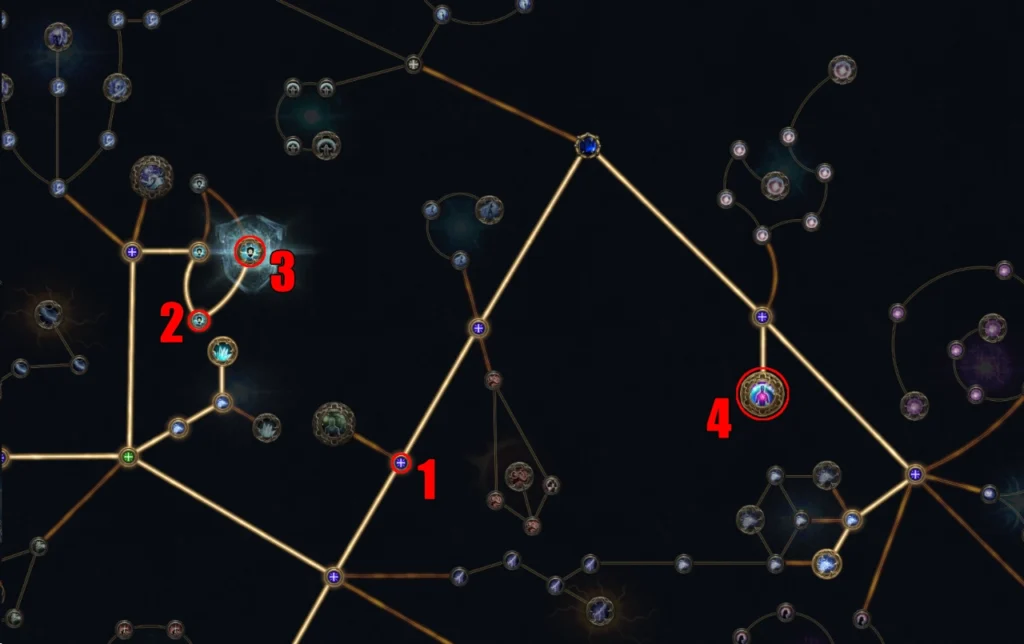
You can use Path of Exile 2's Weapon Specialisation system to further customize your build. Weapon Specialisation is easy for newcomers to use, for veterans to min-max, or anyone who wants thematic builds like a Witch Hunter Mercenary using Crossbows and a Melee Weapon! And if you don't wish to use 2 Weapon sets right away, simply use the Weapon Specialisation points as extra Passives!
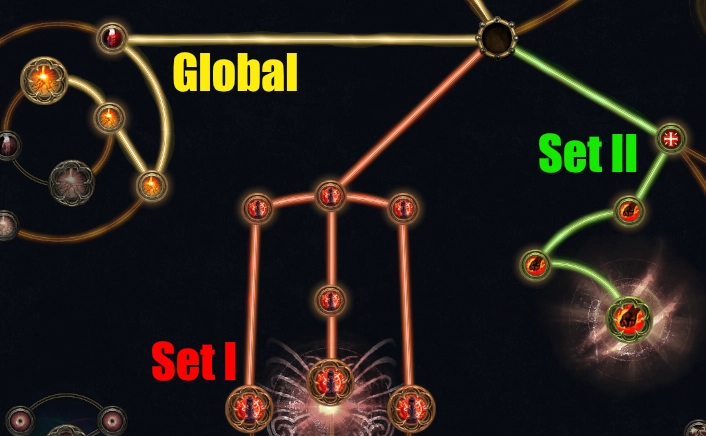
Starting Location
The Tree also adheres to the themes of the Attributes. Intelligence is associated with Lightning and Spells, Dexterity associated with Cold and Projectiles, and Strength is associated with Fire and Melee to name a few. These associations aren't ridged, with the types of Passive clusters blending together as you move towards or away from each quadrant of the Tree.
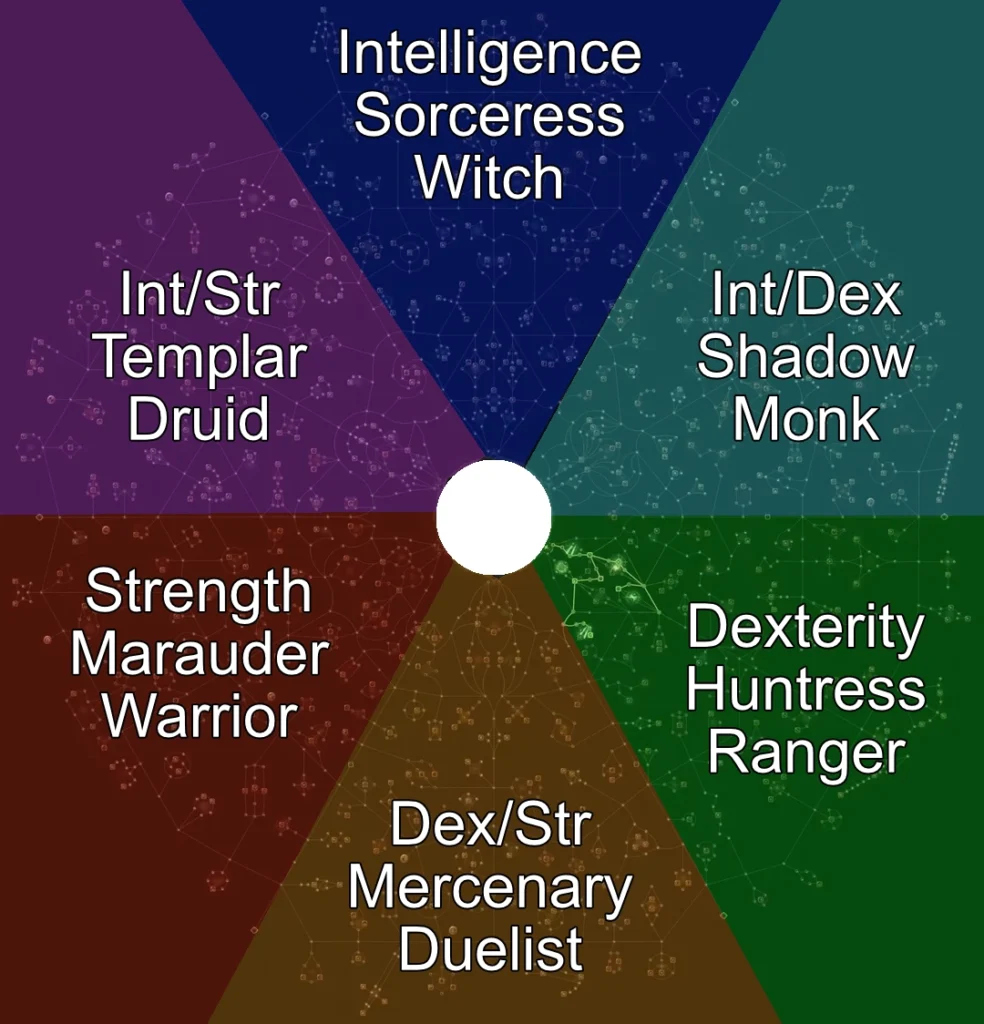
For example, the starting elemental nodes on a Sorceress instead of the Minion nodes available to a Witch. This is to support 2 classes per attribute combination.
When taking travel nodes, you pick between Strength, Dexterity, or Intelligence on each node. This gives you a lot of control over the attributes available to your build, regardless of your starting location.
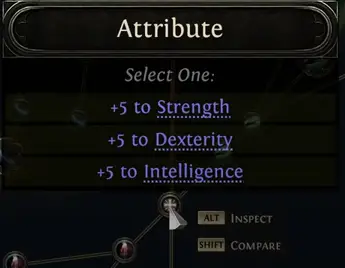
Browse the Passive Tree
If you want to see more about the various nodes, notables and keystones available in Path of Exile 2 you can check our Path of Exile 2 Passive Tree tool or PoE2Planner.
Weapon Specialisation
Path of Exile 2 supports Weapon Specialisation, a way to dynamically shift your Passives based on your active weapon. You get these passives by leveling up and by completing objectives during the Campaign.

The passives obtained from the Quest Books are the ones that allow for Weapon Specialisation. These dynamic passives are limited in number but incredibly powerful. Check out our Quest Guide to make sure you don't miss out on any permanent character buffs!
Skill Gem Weapon Swap Mechanics
By default, your skills use whatever weapon you have equipped at the time. But you can also assign a skill to use a specific weapon. Start by opening your Skill Gem tab and navigating to the extended Gem description.


Here you can configure which Weapon Set your character swaps to when using the Skill. By ticking the first (I) but not the second your character always swaps to your first Weapon Set before using the selected skill. It works the same way when only ticking the second (II) Weapon Set. Tick both at once for you to cast your ability no matter which Weapon Set is active.
The exception here is when you use a Skill that does not meet the required Weapon conditions in one Weapon Set but does in the other, causing it to swap to the eligible one. For example, when you attempt to use Shield Charge while currently holding a 2-handed Mace it swaps to your other Set if that set has a Shield equipped.
Passive Skill Tree Weapon Swap Mechanics
You can also use your Weapon Swap to dynamically change allocated nodes on your Passive Skill Tree. This is called "dual specialization."
Weapon Swap Points are passive points that can be allocated to only be active depending on what Weapon Set is active. To allocate Weapon Set Specific Nodes there are three requirements:
- You have a Weapon Set Point Maximum higher than 0 (24 in the reference image). You acquire these throughout your campaign playthrough.
- You have unallocated Skill Points (9 in the reference image) in order to assign them to a Weapon Set instead of globally.
- You have selected which Weapon Set the following points should be assigned to. (Arrow on the left)
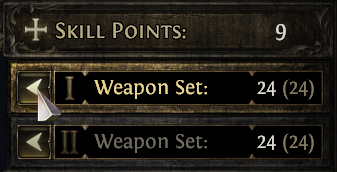


Pay close attention to which nodes are allocated Globally, which to Set I, and which to Set II as you allocate them. Learn more with our Weapon Swap Mechanics Guide!
Refunding Passive Points
Respecialising your Passive tree is easier than ever! You now use Gold, which drops everywhere in the game and is also used as a "Tax" for using the Currency Exchange. If you make a mistake or want to try a new skill or passive combination, simply head to the mysterious Hooded One after you find them in Act 1.

Here you can easily Refund your Passives for Gold. The Refund price is dynamic, with the cost changing with levels and how deep into the Passive tree you are. This means it's much easier to Refund points earlier than in PoE 1. You also get 50% off when Refunding the Attribute nodes, so don't be afraid of choosing a new route on the Attribute highway to explore!
Summary
- The PoE 2 passive tree supports Weapon Specialisation to encourage players to combine multiple Skills and Weapons into their build.
- Most of your passives remain the same.
- Some Passives can be set to a Weapon Set, automatically swapping when that Weapon becomes equipped.
- Assign which Weapon (and therefore Passives) your Skill uses.
- Keystones are much more powerful, but may require some drastic changes to accommodate their downside.
- Starting nodes also change based on your starting class to support 2 classes per Attribute, while the rest of the tree remains the same no matter which class you pick.
- You can pick whether small Attribute Passives grant Strength, Intelligence, or Dexterity.
- You can Refund Passive Points at the Hooded One for Gold once you unlock them in Act 1.
Written by: Tenkiei, Tripolarbear
Contributions by: Cptn_Garbage
Reviewed by: Havoc616, Palsteron, Tripolarbear
